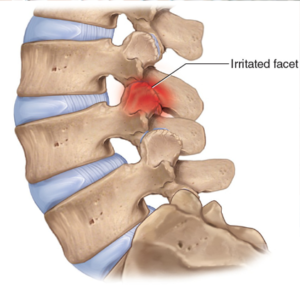What is Facet Syndrome?
Facet syndrome is a specific type of osteoarthritis that develops in the facet joints located in the spine. These joints link the vertebrae and allow the spine to bend, twist and perform other movements. This condition most commonly develops in the cervical (upper) and in the lumbar (lower) spinal regions, but it can also develop in the thoracic (middle) spine as well.
As with many other joints in the body, the facet joints have a smooth, connective tissue known as cartilage that coats the ends of the bones. This cartilage can wear down over time resulting in adjacent bones potentially rubbing together instead of gliding smoothly against each other, creating inflammation within the joint and resulting in pain, stiffness, and loss of mobility in the neck or back.
Sometimes, as the bones grind against each other, the body can create bone spurs (osteophytes) in response. These bone spurs can be asymptomatic, but they can also grow large enough to compress or irritate the nerve roots or spinal cord near the facet joints. If this happens, several additional symptoms in the extremities, such as radiating pain, tingling, numbness and muscle weakness, can develop as a result.

Facet syndrome Causes
Like all cases of osteoarthritis, facet syndrome is most attributed to natural age-related degeneration. Because the facet joints sustain a significant amount of wear and tear throughout a person’s life, many people experience at least a mild degree of facet joint degeneration by the time they enter their 50s. This may not always be symptomatic, but it can also become progressively worse with time.
Sometimes, traumatic injuries can also accelerate degeneration in the facet joints. These can result from vehicle crashes, falls, and sports activities.
Symptoms of Facet Syndrome
Symptoms of facet joint syndrome usually either occur as local aches and stiffness caused directly by the inflamed joints or radiating symptoms caused by a compressed spinal nerve. The location of the affected joint will determine the location of symptoms being experienced. For example, cervical facet joint syndrome may cause the following symptoms:
- Neck pain and stiffness
- Discomfort in the shoulders
- Headaches
- Tingling, numbness, and weakness in the arms and hands
While patients with lumbar facet joint syndrome may experience:
- Lower back pain and stiffness
- Difficulty twisting, bending, and arching
- Pain, cramping, and weakness in the buttocks or thighs
- Trouble getting out of a chair
- Difficulty standing up straight
Risk Factors of Facet Syndrome
The spine is responsible for supporting the weight of the upper body, which puts a tremendous amount of pressure on spinal anatomy, especially the joints and discs. Anything that adds to the pressure being placed on the spine can speed up the degeneration that leads to conditions like facet syndrome. This can include the following:
- Carrying extra body weight
- Poor posture and improper lifting technique
- Engaging in high-impact sports
- Traumatic injury
- An overly sedentary lifestyle
Additionally, smoking, poor nutrition, and excessive alcohol consumption are facet syndrome risk factors because they can decrease blood flow and the replenishment of important nutrients to joint cartilage. If any of these risk factors apply to you, work with your doctor to make the appropriate lifestyle changes that can potentially prevent this condition from developing.
Treatment for Facet Syndrome
Facet joint syndrome in any location of the spine often can be treated with conservative methods. Anti-inflammatory medication, physical therapy, periods of rest, exercise and alternating hot and cold compresses are some of the more effective treatments for this condition. Patients who have found little to no relief after several weeks or months of following these and other doctor-recommended treatments may be asked to consider surgery.